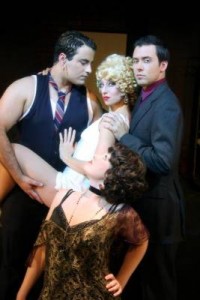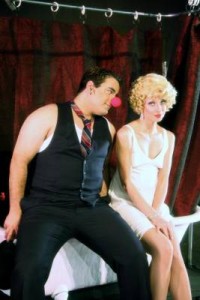
Tell a musical theater aficionado that you’re going to see The Wild Party and the first question you’ll be asked is “Which one?” Will it be the 2000 Broadway show with music and lyrics by Michael John LaChiusa, or will it be the 2000 off- Broadway version with music and lyrics by Andrew Lippa?
That’s right. Two musicals (both based on the 1928 narrative poem by Joseph Moncure March) debuted only minutes from each other in the same year. Both shows deal with the same love quadrangle and both begin with a song whose first words are identical to the poem’s (“Queenie was a blonde and her age stood still, and she danced twice a day in vaudeville. Queenie was a blonde, and if looks could kill, she would kill twice a day in vaudeville.”)
The basic plot is simple. Platinum blonde entertainer Queenie and Burrs, her abusive lover of 7 years, throw a party for their friends, one of whom, a firecracker named Kate, arrives with her latest flame Black. Black and Queenie hit it off, with tragic consequences.
Michael John LaChiusa’s version fleshes out the stories of a dozen or so of the party guests and features a 1920s flavored (and to many ears discordant) score, while Andrew Lippa’s Wild Party focuses mainly on the mismatched pairs of lovers and includes many showstoppers (“Let’s Raise The Roof,” “A Wild Wild Party,” etc.) which have a contemporary Broadway feel (even though Lippa’s was the off-Broadway version).
The Wild Party (a la LaChiusa) had its L.A. debut in a nearly flawless Equity waver production by the Blank Theatre in late 2005 only months after Musical Theatre Guild staged an equally memorable “reading” the Lippa show, but the latter had only a two performance run, leaving Lippa fans starving for a fully staged production. A 2006 L.A. premiere was, unfortunately (or perhaps I should say fortunately) one of the few times I’ve witnessed truly amateurish work on a local stage. Thus, the mostly sensational Orange County premiere of Andrew Lippa’s The Wild Party, just opened at STAGEStheatre in Fullerton, comes as a long wished for treat, and signals the arrival of an important new musical theater talent, 27-year-old director/choreographer/designer T.J. Dawson.
From the moment a gunshot rings out on a darkened stage and an intensely white spotlight reveals the slender peroxide blonde figure of Jeanette Phillips as Queenie, the audience knows that it is in for something special, even more so when Phillips is joined by chorus boys dressed (or undressed) in black a-shirts, boxer briefs, garters, socks and shoes, and by chorus girls in abbreviated black lingerie and red feather boas. As Phillips sings about Queenie, the blonde with “grey eyes, lips like coals aglow” whose “face was a tinted mask of snow,” suddenly from behind the curtain of an onstage bathtub appears the imposing form of Alex Mohajer as Queenie’s abusive lover Burrs, wearing a hobo tux and red clown nose, and the two engage in simulated sex, all the while the boys and girls surrounding them continue the opening number.
And that’s just the start of some of the most adult musical theater ever seen on an Orange County stage.
Though there are a number of stellar performances in the large ensemble cast, the real star of the evening is Dawson, who, though he has based “certain pieces of choreography and direction” on “concepts from the original Off- Broadway production,” is clearly an artist with a vision … and imagination to spare.
Some of the evening’s directorial touches include:
•Queenie in bed surrounded by dancers in black, functioning as a kind of Greek chorus
•A jazz singer singing some sensational scat as Queenie is raped by Burr
•Queenie surrounded by adoring men as if in a Ziegfeld Follies production number
•Kate making a spectacular entrance, lifting her skirt to reveal half a dozen or so flasks attached to garter belts
•“Poor Child” sung by the four leads with spots on each, two of them lit from in front and two from behind
•A drunken nightmare sequence with Burrs surrounded by the entire ensemble hiding their faces behind Queenie masks
•A violent fight sequence which nearly kills both Burrs and Eddie
•An orgiastic scene in which cast members disrobe down to their undies (doubtless left on less out of propriety than because that’s where their mike transmitters are hidden) and copulate in various permutations including some same gender canoodling.
This Wild Party features numerous pizzazzy production numbers choreographed by Dawson, including “Let’s Raise The Roof,” with its Latin beats and wild, abandoned choreography; an electrically staged “The Juggernaut,” danced with kicks and spins (the hardest workout any ensemble will likely ever be given); and a high energy “Let Me Drown” performed by Burrs, Kate, and company. (Dawson was assisted in his choreography by young ballet vet A. J. Abrams, who performs several superlative solos in the role of the mute Jackie, most especially a graceful and poignant “Jackie’s Last Dance.”)
Dawson has assembled a talented and committed cast, and a younger one than might be the case if Actors’ Equity did the right thing and extended their 99-seat plan to Orange County, thus allowing AE performers to work in small theater productions in the O.C.
The breakout performance of the evening is that of Laura Thatcher as Queenie’s dark-haired rival Kate, unrecognizable as the same actress who so delightfully played dumb blonde in January’s Leading Ladies. Thatcher proves herself a force-of-nature actress/vocalist who can belt or sing sweet, and stops the show not once but twice with her solos “Look At Me Now” and “Life Of The Party.
As Queenie, Jeanette Phillips bravely surmounted opening night mike troubles, proving herself a fine actress in a very difficult role. Vocally, Queenie challenges even virtuoso singers like Off-Broadway’s Julia Murney and MTG’s Tami Tappan Damiano, but Phillips gives it her all, with a passionate rendition of “Maybe I Like It This Way” being one of the evening’s highlights.
Alex Mohajer is a big guy, making his Burrs truly scary opposite waif-slim Phillips. Vocally strong, he also reveals all three dimensions of this “villain” and his and Phillips’ performance of “What Is It About Her” concludes Act 1 with a WOW!
Completing the quartet of lovers is handsome David Belowich, an ingratiating performer who does his best despite being challenged by the demands of Lippa’s music.
Unlike LaChiusa’s The Wild Party, Lippa’s version gives only three of the peripheral characters their own songs. Fortunately for the trio of performers (and for the audience), Lippa has written them a pair of show stopping numbers.
Cheryl Daro brings down the house with sex appeal and a deep sultry voice as lesbian Madeline True, looking like a cross between Norma Desmond and the Spider Woman. Her dazzlingly inventive “Old Fashioned Love Story” is the kind of performance than wins awards for a single song.
Alternate Christopher Van Etten as pugilist Eddie and Lola Ward as his giggly girlfriend Mae channel Ernest Borgnine and Betty Boop in the charming and funny “Two Of A Kind.”
In smaller roles, Joshua Lay and Brenda Kondratczyk delight as gay lovers Phil and Oscar, wearing twin suits and mustaches. Others in the exceptional ensemble (who never leave the stage) are Danielle Beckmann, Cate Conroy, Ryann Crofoot, Kyle Dallatore, Max McMullin, Bailey Quist, Shaun Samaro, Adam Secousse, and (notably) American Idol-ready Drew Tablak, who sings scat like a seasoned jazz pro and later belts high notes to the rafters in “A Wild, Wild Party.”
Technically and design-wise as well, this is a first-rate production. Foxton Lewyn’s lighting is spectacularly imaginative, as are Annie Riley and Dawson’s costumes. Mitch Faris’ set is simple but mobile, allowing the audience to view the party from different angles. Coryn Ellis and Jeff Weeks deserve high marks for make- up and wigs.
The songs are performed to tracks prerecorded especially for the show by musical director/pianist Stephen Armundson, backed by Alexander “Lex” Leigh, Brian Boyce, Justin Smith, Rich Cozzi, Michael Fortunado, and David Shoop, engineered by Marcus Junkin, with sound design by Phillip Roa. Though a certain “live” quality is lost by prerecording, what is gained is a “big” sound that gives the show far more power than a small live combo would have provided. The music cues are perfectly timed, though the volume was too high for my eardrums.
STAGEStheatre’s The Wild Party received a huge (and deserved) ovation from Friday’s opening night audience and the show can only improve and tighten as the run continues. Lippa fans who’ve been waiting for a class production of his Wild Party now have reason to rejoice.
STAGEStheatre, 400 E. Commonwealth, Fullerton.
www.stagesoc.org
–Steven Stanley
April 4, 2008
Photo: Steve Campbell




 Since 2007, Steven Stanley's StageSceneLA.com has spotlighted the best in Southern California theater via reviews, interviews, and its annual StageSceneLA Scenies.
Since 2007, Steven Stanley's StageSceneLA.com has spotlighted the best in Southern California theater via reviews, interviews, and its annual StageSceneLA Scenies.







 COPYRIGHT 2024 STEVEN STANLEY :: DESIGN BY
COPYRIGHT 2024 STEVEN STANLEY :: DESIGN BY